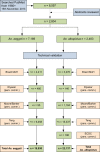The global compendium of Aedes aegypti and Ae. albopictus occurrence
- PMID: 26175912
- PMCID: PMC4493829
- DOI: 10.1038/sdata.2015.35
The global compendium of Aedes aegypti and Ae. albopictus occurrence
Abstract
Aedes aegypti and Ae. albopictus are the main vectors transmitting dengue and chikungunya viruses. Despite being pathogens of global public health importance, knowledge of their vectors' global distribution remains patchy and sparse. A global geographic database of known occurrences of Ae. aegypti and Ae. albopictus between 1960 and 2014 was compiled. Herein we present the database, which comprises occurrence data linked to point or polygon locations, derived from peer-reviewed literature and unpublished studies including national entomological surveys and expert networks. We describe all data collection processes, as well as geo-positioning methods, database management and quality-control procedures. This is the first comprehensive global database of Ae. aegypti and Ae. albopictus occurrence, consisting of 19,930 and 22,137 geo-positioned occurrence records respectively. Both datasets can be used for a variety of mapping and spatial analyses of the vectors and, by inference, the diseases they transmit.
Conflict of interest statement
The authors declare no competing financial interests.
Figures





Dataset use reported in
- doi: 10.7554/eLife.08347
References
Data Citations
-
- Kraemer M. U. G. 2015. Dryad Digital Repository. http://dx.doi.org/10.5061/dryad.47v3c - DOI
References
-
- Reinert J. F., Harbach R. E. & Kitching I. J. Phylogeny and classification of tribe Aedini (Diptera: Culicidae) . Zool. J. Linn. Soc. 157, 700–794 (2009).
Publication types
MeSH terms
Grants and funding
LinkOut - more resources
Full Text Sources
Other Literature Sources
Medical

